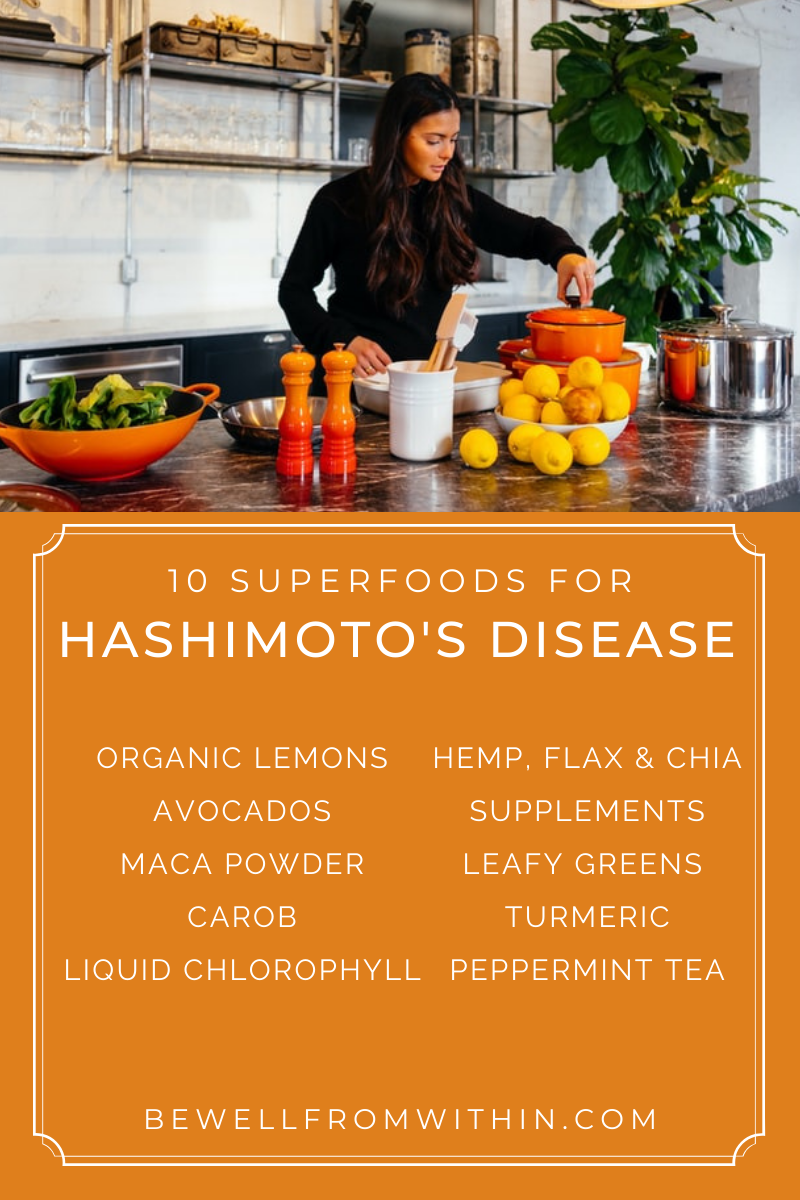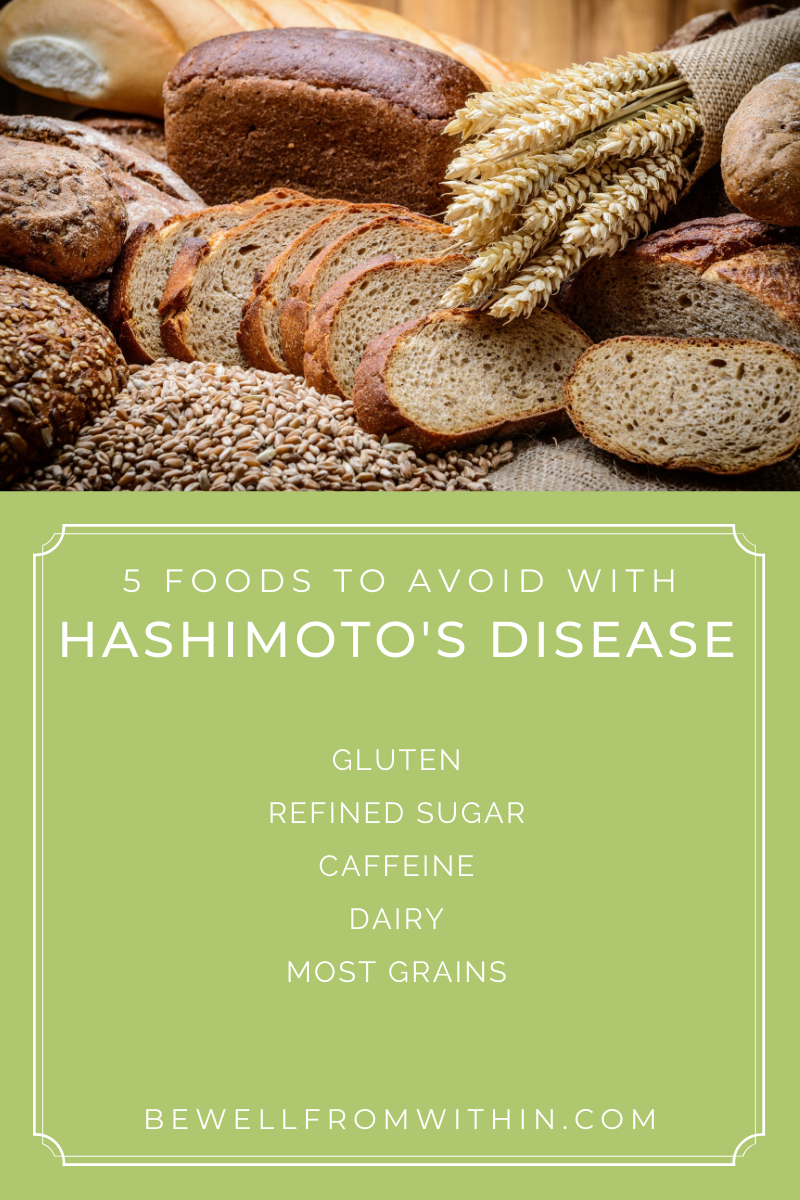Healing From Hashimoto’s: 10 Superfoods to Eat Daily with Autoimmune Thyroid Disease

In late 2020, I was diagnosed with Hashimoto's disease after years of experiencing a whole slew of mystery health issues. As an autoimmune condition, Hashimoto’s disease occurs when the immune system attacks the thyroid — the butterfly-shaped endocrine gland found at the base of the neck. And as a result, the thyroid struggles to produce a healthy amount of thyroid hormones — which can lead to memory and concentration issues, fatigue, changes in weight, hair loss, depressed mood, and a bunch of other strange symptoms.
Prior to my diagnosis, I knew something had been off in my body for about seven years. However, getting a formal diagnosis — and a doctor who'd listen to my symptoms and not brush them off as being the result of stress or anxiety — was incredibly difficult. I certainly was stressed and anxious, but mostly because I was obsessing over my health and wondering what the heck was going on!
By the time I was finally diagnosed with Hashimoto’s disease, my thyroid hormones (including my TSH, T3, and T4 levels) had all been checked on at least 10 separate occasions. My TSH levels were always on the higher end of “normal”, but I was never tested for thyroid antibodies (e.g. thyroid peroxidase antibodies and thyroglobulin antibodies) until I’d specifically asked for these tests.
By that point, I'd already suffered from years and years of debilitating fatigue, brain fog, concentration issues, chronically dry skin and scalp, anxiety, and unexplained body aches and pains. And looking back at old photos of myself, I can hardly believe how puffy my face was at times!
During what I'd later know to be a "Hashimoto's flare-up", I also experienced a choking/squeezing feeling in my neck that made speaking and swallowing a challenge. It almost felt like someone was wrapping their hands around my throat and I would struggle to get the words out of my mouth when speaking. Plus, my body aches and pains worsened during this time (especially in my neck, back, and right wrist). I was only 32 by the time I was diagnosed with Hashimoto’s, but some days, I felt double that.
I'm sure it'll take some time before my symptoms begin to subside (especially the brain fog and concentration issues I’ve been struggling with for years), but I'm working day in and out to get my health back on track and feel my absolute best. And while I am taking thyroid medication to lower my TSH levels and alleviate some of my symptoms, dietary and lifestyle changes have also been a big part of my healing journey.
Here are 10 of the foods I eat daily in an effort to treat — and heal from — Hashimoto's disease:
1. Lemon
Since I started taking levothyroxine for my autoimmune thyroid disease, I stopped drinking coffee or tea first thing in the morning and replaced these beverages with hot lemon water. Levothyroxine must be taken on an empty stomach — at least 30 minutes before any foods or beverages — and hot lemon water has been a surprisingly effective substitution for caffeine. I find that hot lemon water energizes me first thing in the morning and stimulates my digestive system.
2. Avocados
Avocados are extremely versatile. You can add them to sandwiches, mash them up and eat them with chips, make pestos and sauces, and even blend them into smoothies or chocolate avocado pudding. Plus, they’re packed full of nutrients such as potassium, fiber, monounsaturated fats, and vitamins C, E, K, and B-6. Oh, and did I mention they’re delicious? Sometimes I’ll slice one in half, sprinkle on some sea salt, and eat them as is.
3. Maca Powder
The ancient adaptogen known as maca root packs a number of impressive benefits, which is why I add the superfood to smoothies, mix it into my cashew milk yogurt, and make my own maca lattes using coconut milk, cacao powder, cinnamon, and of course, maca powder. Researcher Gustavo F. Gonzales reports in a 2012 issue of Evidence-Based Complementary and Alternative Medicine that maca boosts mood, memory, and sexual function — and aids in disease prevention.
4. Carob
I have a major sweet tooth, and carob powder satisfies it most of the time. I sprinkle it on dairy-free ice cream, use it to make teas, and blend it into smoothies. According to an article published in a 2015 edition of Comprehensive Reviews in Food Science and Food Safety, carob powder contains anticarcinogenic and antidiabetic properties — and it’s effective for easing diarrhea, lowering cholesterol, and fighting free radicals.
5. Liquid Chlorophyll
Liquid chlorophyll is another superfood that reduces free radicals in the body and fights inflammation. I add a tablespoon to green smoothies or mix it into a tall glass of water. But you can easily up your chlorophyll intake by consuming plenty of spinach, asparagus, collard greens, parsley, and broccoli.
6. Hemp, Flax, or Chia seeds
They’re called “super seeds” for a reason: Hemp, flax, and chia seeds are all packed with protein, Omega-3 fatty acids, fiber, and minerals such as calcium, iron, and magnesium. I add them to my smoothies and yogurt parfaits, sprinkle them on salads, and mix them into soups and spaghetti sauces.
7. Dietary Supplements
After reading The Hashimoto’s Protocol by Dr. Izabella Wentz, I’ve started taking a handful of dietary supplements several times throughout the day. A few of them include Saccharomyces boulardii (S. bouldarii), probiotics with 50 million colony-forming units (CFUs), selenium, and benfotiamine. A couple of times a week, I also add a plant-based protein powder with probiotics to my smoothies, smoothie bowls, and yogurt parfaits.
8. Leafy Greens
I consume a plant-based diet, so much of what I eat consists of fresh leafy greens. My favorites include spinach, swiss chard, cilantro, and lightly steamed or sauteed kale. I aim to consume greens with most of my meals, including my morning smoothie!
9. Turmeric
Since my diagnosis, I’ve started taking turmeric in several ways. I alternate between taking it in supplement form, making my own turmeric tea, sprinkling turmeric powder into my daily smoothies, and juicing turmeric root with fresh fruits and veggies. I’ve also been cooking with turmeric more than ever before. Thanks to its anti-inflammatory properties, turmeric eases sore muscles, protects the brain from disease, and may be used to manage anxiety. However, the spice is best taken with black pepper to increase absorption in the body.
10. Peppermint Tea
Peppermint tea has become a daily staple largely because of how much it calms my digestive system. As someone who has battled irritable bowel syndrome (IBS) for years, nothing calms my stomach (especially symptoms like diarrhea, gas, and stomach pains) quite like a hot mug of peppermint tea. And according to a review article published in a 2006 issue of Phytotherapy Research, peppermint tea is antimicrobial, antiviral, antitumor, and antioxidant-rich.

Foods to Avoid With Autoimmune Thyroid Disease
Now, let's talk about some of the foods I don't usually eat because of my Hashimoto’s diagnosis: These include:
- Gluten. After conducting a clinical trial involving 34 women with Hashimoto’s disease, researchers Robert Krysiak, Witold Szkróbka, and Bogusław Okopień reported in Experimental and Clinical Endocrinology & Diabetes that gluten-free diets could positively impact those with autoimmune thyroid disease — even those who test negative for celiac disease. So, what is there to lose by going gluten-free?
- Refined sugar. Instead, I use coconut sugar, stevia, or maple syrup whenever I would normally use refined white sugar in recipes.
- Caffeine. This one's temporary, but I'm currently abstaining from caffeine and drinking herbal teas instead. My favorite coffee alternative is Dandelion Dark Roast and Dandelion Caramel Nut by Teeccino.
- Dairy. As a vegan, I’ve avoided dairy for many years. Which is a good thing since Hashimoto’s has been linked to lactose intolerance and higher TSH levels, according to a 2014 article published in the International Journal of Basic and Clinical Endocrinology. Here I share some tips for eliminating dairy and opting for dairy alternatives such as almond milk and cashew-based cheeses.
- Most grains. I avoid grains as best as possible, choosing gluten-free pseudograins such as quinoa and buckwheat over corn, wheat, and white or brown rice. However, I’ve recently started to reintroduce oats and rice after about six months of eliminating them from my diet.

You Can Still Enjoy Food With an Autoimmune Disease
When I first started researching Hashimoto’s and the different foods I should and shouldn’t eat due to the disease, I panicked. I thought holiday celebrations, nights out with friends, easy weeknight dinners, and takeout meals were all things of the past. When you’re avoiding gluten, grains, sugar, caffeine, meat, and dairy, what else is there to eat?
But that’s why the bulk of this article is focused on the foods I eat daily, rather than the foods I avoid. While I’ve avoided dairy for years and do my best to stay away from gluten, grains, and sugar, I’ll occasionally allow myself to enjoy traditional pizza crust or a gluten- and sugar-containing cupcake. Part of managing an autoimmune disease has a lot to do with keeping stress levels under control, and I’m not going to worsen the situation by worrying about every little thing I’m eating
You can still eat well while battling an autoimmune disease: You just have to find the best foods for you and your body. It takes some trial and error — and months of eliminating and reintroducing foods — but the process can be enjoyable if you allow it to be!
References:
- Asik, Mehmet et al. “Decrease in TSH levels after lactose restriction in Hashimoto's thyroiditis patients with lactose intolerance.” Endocrine vol. 46,2 (2014): 279-84. doi:10.1007/s12020-013-0065-1
- Cleveland Clinic. “Are There Health Benefits to Using Liquid Chlorophyll?.” Last modified May 13, 2021. https://health.clevelandclinic.org/are-there-health-benefits-to-using-liquid-chlorophyll/
- Cleveland Clinic. “Why Avocados Are a Healthy — and Delicious — Addition to Your Diet.” Last modified September 15, 2020. https://health.clevelandclinic.org/why-avocados-are-a-healthy-addition-to-your-diet/
- Franciscan Health. “Health Benefits Of Chia, Flax And Hemp Seeds.” Last modified July 11, 2019. https://www.franciscanhealth.org/community/blog/super-seeds-health-benefits-chia-flax-and-hemp-seeds
- Gonzales, Gustavo F. “Ethnobiology and Ethnopharmacology of Lepidium meyenii (Maca), a Plant from the Peruvian Highlands.” Evidence-based complementary and alternative medicine : eCAM vol. 2012 (2012): 193496. doi:10.1155/2012/193496
- Hewlings, Susan J, and Douglas S Kalman. “Curcumin: A Review of Its Effects on Human Health.” Foods (Basel, Switzerland) vol. 6,10 92. 22 Oct. 2017, doi:10.3390/foods6100092
- Krysiak, Robert et al. “The Effect of Gluten-Free Diet on Thyroid Autoimmunity in Drug-Naïve Women with Hashimoto's Thyroiditis: A Pilot Study.” Experimental and clinical endocrinology & diabetes : official journal, German Society of Endocrinology [and] German Diabetes Association vol. 127,7 (2019): 417-422. doi:10.1055/a-0653-7108
- McKay, D.L. and Blumberg, J.B. (2006), A review of the bioactivity and potential health benefits of peppermint tea (Mentha piperita L.) . Phytother. Res., 20: 619-633. doi:10.1002/ptr.1936
- Nasar-Abbas, S.M., e-Huma, Z., Vu, T.-H., Khan, M.K., Esbenshade, H. and Jayasena, V. (2016), Carob Kibble: A Bioactive-Rich Food Ingredient. COMPREHENSIVE REVIEWS IN FOOD SCIENCE AND FOOD SAFETY, 15: 63-72. doi:10.1111/1541-4337.12177
- National Institute of Diabetes and Digestive and Kidney Diseases (NIDDK). “Hashimoto’s Disease”. Accessed June 17, 2021.
- https://www.niddk.nih.gov/health-information/endocrine-diseases/hashimotos-disease
Well From Within offers freelance blogging services to health and wellness businesses. For more information, please check out my blogging services and rates, or take a moment to learn how blogging can benefit your health and wellness business.

